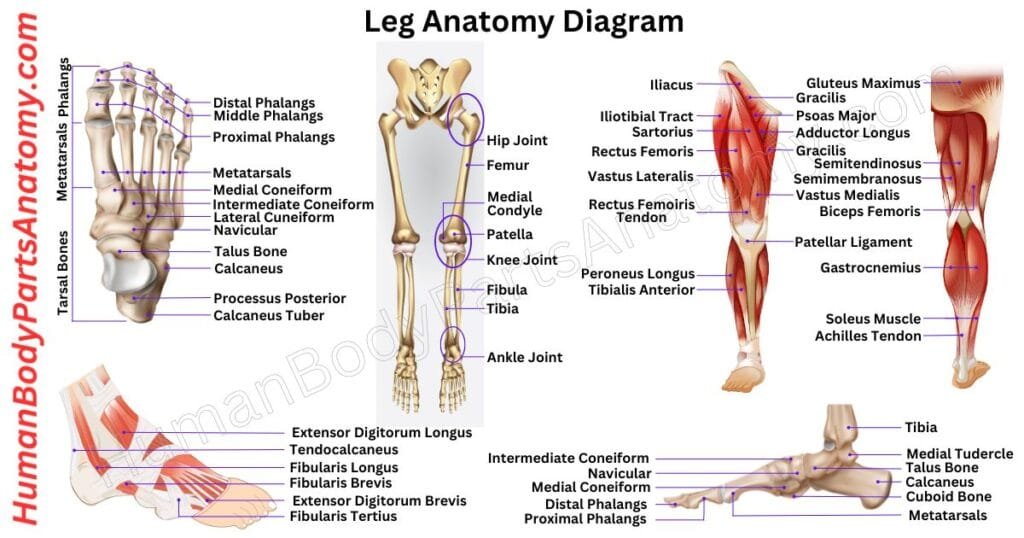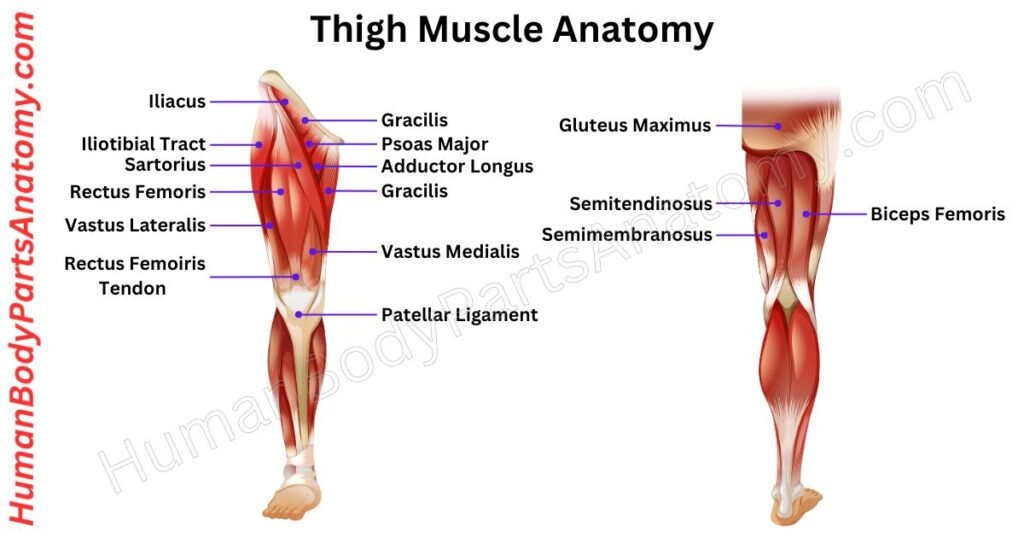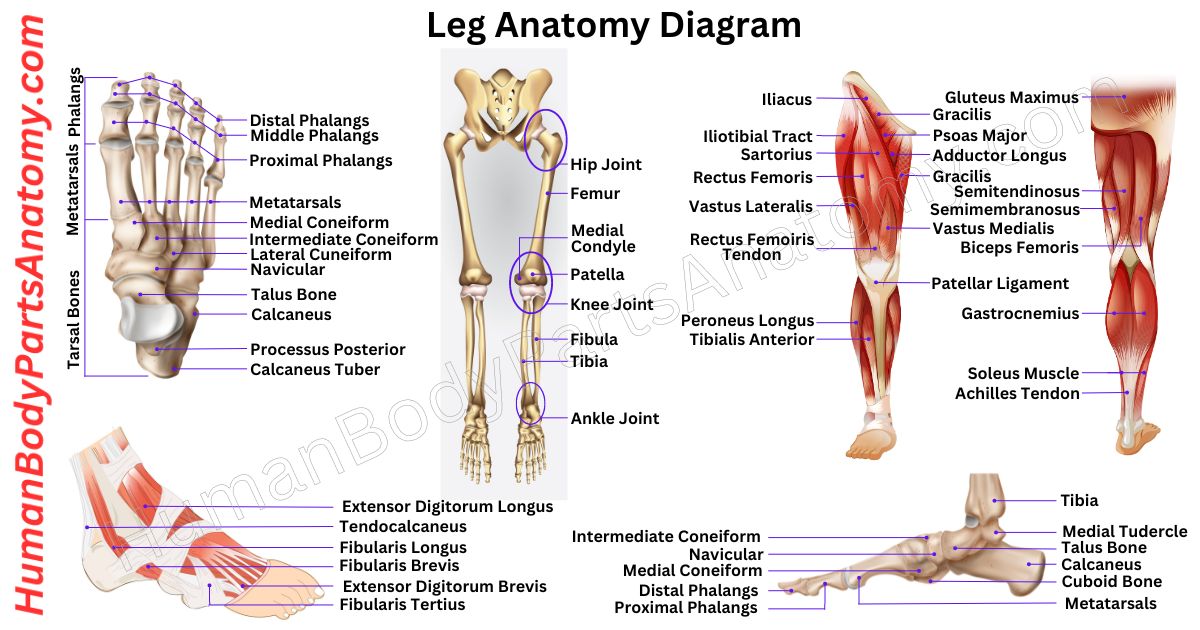Overview of Leg Anatomy
The legs are the parts of the human body below the hip and above the foot. Leg anatomy is made up of big bones like the thigh bone (femur), the shin bone (tibia), and a smaller bone fibula. Your thigh is the top part of your leg, between your hip and knee, and your calf is the back part below your knee. The shin, or front part of your lower leg, is where your shinbone is. Legs are important for standing, walking, and other movements like dancing. They have evolved to help us walk on two feet efficiently, which is something not all animals can do as well as we can. In humans, there are some differences between male and female legs, like the angle of the hips and knees and the length of certain bones. But generally, legs serve the same basic purpose for everyone.
In this article, we are going to see the leg anatomy to know more about the human legs and what bones, muscles, tendons, ligaments & nerves are present inside.
Leg Anatomy Diagram

Parts of the Leg
Leg Bones
- Femur
- Patella
- Tibia
- Fibula
Joints
- Hip Joint
- Knee Joint
- Ankle Joint
- Subtalar Joint
Leg Muscles
- Thigh
- Gastrocnemius
- Soleus
- Tibialis Anterior
- Peroneus Longus
- Peroneus Brevis
Tendons
- Achilles Tendon
- Tibialis Posterior Tendon
Ligaments
- Anterior Cruciate Ligament (ACL)
- Posterior Cruciate Ligament (PCL)
- Medial Collateral Ligament (MCL)
- Lateral Collateral Ligament (LCL)
Leg Bone Anatomy
Femur
The femur is also known as the thigh bone. It is the longest and strongest bone in the human body. It gives us the ability to stand and move with strength and stability.
This bone is subdivided into three different parts: the upper portion (proximal), the central body (shaft), and the lower section (distal).
In the leg anatomy, the role of the femur is not only limited to facilitating physical movement. It holds most of our body weight and connects various muscles, ligaments, and tendons present in the hip & knees to the rest of human body parts.
Within the shaft of the femur, we can see both red and yellow bone marrow, which play essential roles in generating blood cells and fat storage.

Read More – Femur Anatomy: Complete Guide with Parts, Names, Functions & Diagram
Patella
The patella or kneecap is a triangular and flat bone in a central position at the front of the knee joint. It helps to connect the femur and tibia in the knee area.
The main role of the patella comes during the process of knee extension. Also, it has another critical function to facilitate the easy movement of the knee during both flexion and extension.
Additionally, it acts as a protective shield for the anterior surface of the knee joint, safeguarding it from potential harm.
Tibia
The tibia is one of the two bones in the leg and plays a vital role as the primary weight-bearing bone. It has greater size and strength rather than the fibula.
The tibia articulates with the femur to form the knee joint and part of the ankle joint alongside the fibula and talus. The tibia runs medially (on the inner side) about the fibula, extending from just below the knee joint to the ankle joint.
Functionally, the tibia bears the load of your body when you stand and move. It helps in providing essential stability as you go about your daily activities.
Fibula
The fibula is a thin, long bone in your lower leg. It is next to the larger tibia, on the outer side of your leg. It starts at the knee, runs down the side of your leg, and ends at the ankle.
At the top, the fibula has a head that sits just behind the tibia’s head. Below the head is a narrow part called the neck.
The main part of the fibula is called the shaft. It has three sides: one facing outward, one facing inward, and one facing backward.
Near the ankle, the fibula forms the lateral malleolus with the talus, forming part of your ankle joint. The fibula is attached to the tibia along its length by a tough tissue called the interosseous membrane.
This connection doesn’t allow much movement, helping to keep the two bones stable.
Leg Muscle Anatomy
Thigh
The thigh is the part of your upper leg. It is the portion between the hip and the knee. The main bone in the thigh is called the femur, which is the longest and strongest bone in your body.
Inside the thigh, there are three compartments. Each compartment has its own set of muscles, nerves, and blood vessels.
Medial Compartment: It contains muscles that bring your legs toward each other, called adductors. Posterior Compartment: It includes the hamstring muscles, which help you bend your knee and extend your hip.
Anterior Compartment: It contains muscles that help you straighten your knee, which is important for walking, running, and kicking. These compartments are separated by strong tissue called fascia.

Read More – Complete Guide to Thigh Muscle Anatomy: Learn Parts, Names & Diagram
Gastrocnemius
The gastrocnemius muscle, also known as the “calf muscle,” is a large muscle at the back of your lower leg. It has two parts that start just above your knee and end at your heel. The muscle goes over three important joints: the knee, the ankle, and the subtalar joint in the foot.
Its main job is to help you point your toes down (plantar flexion), like when you stand on tiptoe, and to bend your knee. Because of this, it is important for activities that need quick movements, like running and jumping.
The gastrocnemius has mostly “fast-twitch” muscle fibers. These fibers are great for quick bursts of energy but only last for a short time. It makes the gastrocnemius great for sprinting and jumping but less suited for endurance.
Soleus
The soleus muscle is important in the lower leg, located deep in the calf, and works closely with the gastrocnemius muscles. Together, these two muscles form a triceps surae.
The soleus has a complex structure. It has many muscle fibers that attach to different places on the leg bones. Most of these fibers start below the knee and go down to the heel bone, while some start at various spots on the back of the leg bones.
Some of them attach to a flat structure called the anterior aponeurosis. In contrast, others connect to another similar structure called the posterior aponeurosis. This muscle helps us stand and walk.
Tibialis anterior
The tibialis anterior muscle is the large muscle out of four muscles present in the front part of your lower leg. It is thick and starts from the upper part of your outer shin bone (the tibia).
This muscle is essential for two main movements: raising your foot upward (dorsiflexion) and turning the sole of your foot inward (inversion).
It consists of several bones, including the heel bone (calcaneus), ankle bone (talus), and others like the navicular, cuneiforms, and the first three metatarsals.
The tibialis anterior plays a key role in walking, running, and overall foot stability. When we contract this muscle, it not only raises your foot but also helps support the natural arch of your foot.
Peroneus Longus
The peroneus longus muscle is one of two muscles on the outer side of your lower leg. It is controlled by the nerve (L5-S2) from your lower back and gets its blood supply from certain leg arteries.
This muscle helps in pointing your foot downwards and turning it outward. It starts from the top and outer part of the long leg bone (fibula) and attaches to the base of your big toe and inner foot bone.
It works with the peroneus brevis. Together, it help in moving your foot in different directions. But sometimes, the peroneus longus muscle can get hurt. It can happen from sudden movements that twist or bend your ankle unnaturally.
Peroneus Brevis
The peroneus brevis is a muscle located on the outer side of the lower leg, below the peroneus longus. It facilitates turning your foot forth and pointing your toes downward.
The superficial peroneal nerve sends signals to this muscle, while the peroneal artery provides blood flow. It originates on the outside of the lower thigh bone (fibula). It connects to the outside of the fifth toe bone (metatarsal).
The peroneus brevis is shorter and thicker than the peroneus longus. Its tendon begins slightly above the outside ankle bone, wraps around the ankle, and attaches to the outside edge of the fifth toe bone.

Leg Anatomy: Joint
Hip Joint
The hip joint is also known as a ball-and-socket joint. It has a “ball” at the top of the thigh bone (femur) that fits into a “socket” in the hip bone (acetabulum).
This design allows the hip joint to move in many directions. It can bend and straighten (flexion and extension), rotate (internal and external rotation), and move sideways (abduction and adduction).
One of the main jobs of the hip joint is to support the weight of your body when you are standing, walking, or running. It also helps transfer force from your upper body to your legs, allowing you to move.
The hip joint is strong and stable, partly because of the deep socket that holds the femur in place. There is also a ring of tough cartilage called the acetabular labrum around the edge of the socket, which helps keep the joint secure.
This cartilage has a few important roles:
- It helps spread the pressure when you put weight on your hips.
- It creates a kind of suction that helps keep the joint stable, like a vacuum seal.
- It also helps control the flow of the fluid that lubricates the joint, which keeps everything moving smoothly.

Knee Joint
The knee is the largest joint in our body. It is mainly operating as a hinge for bending and straightening the leg. Its structure involves two key articulations: the tibiofemoral and patellofemoral joints, which together create a compound synovial joint.
This joint is essential for efficient activities like walking, running, and jumping. The bones involved in knee articulation are complex.
The femur has a slight inward slant, while the tibia is almost vertical. The patella, the largest sesamoid bone in the body, sits at the front of the knee. It serves as the endpoint for the quadriceps tendon and shields the front surface of the femur.
The articulating surfaces at the knee include the lateral and medial condyles of the femur and tibia, as well as the front-to-back connection between the patella and femur.

Read More – Knee Anatomy: Complete Guide to Parts, Names, Functions & Diagram
Ankle Joint
The ankle joint is formed by the joining of three bones- the talus, tibia, and fibula. It is a socket where the talus bone sits, surrounded by the tibia and fibula. The bony prominence on the lower fibula, the malleoli, helps form the edges of this joint.
During walking, the ankle adjusts to different surfaces. It can move in four main ways- pushing your toes down (plantarflexion), pulling them up (dorsiflexion), tilting the sole of your foot inwards (inversion), or tilting it outwards (eversion).
Subtalar Joint
The subtalar joint is also known as the talocalcaneal joint. It is where the talus bone and the calcaneus bone meet in the foot.
There are three points where they connect- two in the front and one in the back. These connection points are called facets, with one at the back, one in the middle, and one in the front.
At the front and middle connections, the shape of the talus fits into the shape of the calcaneus, with the talus being convex and the calcaneus being concave. In the back connection, the talus is concave, and the calcaneus is convex.
The middle connection has a structure called the sustentaculum tali as its floor, and the front connection fits snugly against the head of the talus.
Sometimes, the middle and front connections are combined into one. The back connection is the largest and is separated from the others by a structure called the tarsal canal.
This joint allows the foot to move from side to side (inversion and eversion). However, it does not have much to do with moving the foot up or down (dorsiflexion or plantarflexion).
Read More-
Lower Limb
- Complete Guide to Thigh Muscle Anatomy: Learn Parts, Names & Diagram
- Knee Anatomy: Complete Guide to Parts, Names, Functions & Diagram
- Femur Anatomy: Complete Guide with Parts, Names, Functions & Diagram
Upper Limb
- Complete Guide to Finger Anatomy with Parts, Names, Functions & Diagram
- Comprehensive Guide to Arm Anatomy: Parts, Names & Diagram
- Comprehensive Guide to Hand Anatomy: Parts, Functions & Diagram
- Ultimate Guide to Bicep Anatomy: Parts, Names, Functions & Diagram
- Shoulder Anatomy: Ultimate Guide to Parts, Names, Functions & Diagram
- Wrist Anatomy: Ultimate Guide to Parts, Names, Functions & Diagram
- Complete Guide to Nail Anatomy with all Parts, Names & Diagrams
Human Head
- Ultimate Guide to Eye Anatomy: Parts, Structure, Functions & Diagram
- Tongue Anatomy: Complete Guide with Parts, Names, Functions & Diagram
- Mouth Anatomy: Complete Guide with Parts, Names, Functions & Diagram
- Complete Guide to Tooth Anatomy: Learn Parts, Names & Diagram
- Ultimate Guide to Ear Anatomy: Parts, Structure, Functions & Diagram
External Sources-
- Wikipedia
- KenHub
- Optometrists
- Cleveland Clinic
- American Academy of Ophthalmology

